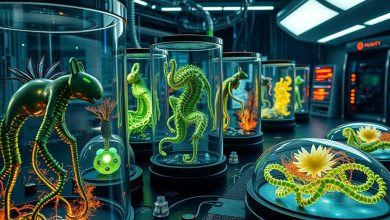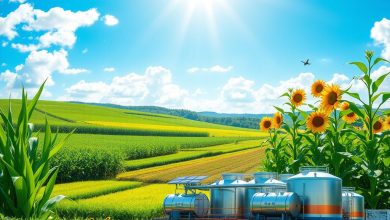Modified Algae: A Sustainable Source of Biofuel

Did you know a single cubic meter of Nannochloropsis microalgae can power a car for over 200 miles? This shows how much potential modified algae has as a green energy source. As we look for new ways to fuel our cars, scientists are focusing on these tiny plants.
Mazda and Hiroshima University are working together to make biofuel from algae. They use special technology to make these algae better at producing fuel. Their goal is to find a cleaner alternative to gasoline and cut down on CO2 emissions.
Exploring modified algae and its role in biofuels is an exciting journey. It’s about science, caring for our planet, and working towards a greener future. Let’s dive into the science and benefits of this innovation that could change how we use energy.
Understanding the Potential of Algal Biofuel Production
The world is looking for new, green energy sources. Algal biofuel production is getting a lot of attention. Microalgae, tiny water plants, are seen as a great option for making biofuel.
The Science Behind Algae-Based Energy
Microalgae, like Nannochloropsis, can hold up to 50-60% lipids in their cells. This makes them a top choice for biofuel. They use sunlight to turn CO2 into lipids, which can then be turned into biofuel.
Key Benefits of Algal Biofuels
- Low environmental impact: Algal biofuel production has a much lower carbon footprint than fossil fuels. It even recycles CO2.
- Renewability: Algae can be grown over and over, offering a constant, green biofuel source.
- High productivity: Algae can produce 10 to 100 times more fuel per area than traditional crops. They are very efficient.
Current Challenges in Production
Despite its promise, making algal biofuel faces big challenges. Scientists are working hard to grow more algae and make it into fuel. They’re using genetic changes and better growing conditions to solve these problems.
Modified Algae for Biofuel: A Game-Changing Innovation
Mazda and Hiroshima University are working together to create a clean fuel for diesel engines. They use bioengineered algae for this project, starting in 2017. They aim to make a fuel that’s good for the planet and can replace fossil fuels.
They’ve been testing this new fuel on racetracks since 2021. Their goal is to make a fuel that’s both clean and practical. This could help a lot in reducing CO2 emissions and reaching carbon neutrality.
The secret to this success is changing the algae’s genes. They’ve made the algae, Nannochloropsis, better at making lipids. Lipids are what you need to make biofuel. This bioengineered algae could solve the problem of making biofuel cheaply and on a large scale.
This new biofuel technology could be a big step forward for green energy. Microalgae grow fast, make lots of lipids, and can live in many places. This could change how we think about fuel for cars and trucks, making them more eco-friendly.
Genetic Engineering Techniques in Algae Modification
Algae biotechnology has seen big leaps forward. Scientists are using new genetic engineering methods to make algae better. They’re working on making more lipids and better biofuels by changing the algae’s genes.
DNA Manipulation Methods
CRISPR/Cas9 is a key tool in changing algae’s DNA. It lets scientists change specific genes in the algae. This helps improve traits like lipid production and photosynthesis.
 Artificial Organs: The Future of Transplants
Artificial Organs: The Future of Transplants Strain Selection and Optimization
Choosing the right algae strains is also important. Scientists look for the best Bioengineered Algae and test them in different conditions. This helps find the most productive algae for Lipid Extraction Techniques.
Enhancement of Lipid Production
Boosting lipid production is a main goal. Genetic engineering helps make more lipids in algae. This makes algae-based biofuels more efficient and sustainable.
Bioreactor Design and Cultivation Systems
Unlocking microalgae’s potential as a sustainable biofuel source needs better bioreactor design and cultivation systems. Improving Microalgae Cultivation, Bioreactor Design, and Biomass Conversion Processes is key.
Companies like Mazda have set up special facilities for microalgae cultivation. These facilities have tanks much bigger than research ones. They allow for more experiments and scaling up.
These setups include devices to speed up photosynthesis in microalgae. They use seawater, nutrients, and a CO2-rich air system. This helps grow more biomass for biofuel.
| Cultivation System | Distribution in Europe | Key Benefits |
|---|---|---|
| Photobioreactors | 71% | Improved CO2 fixation and biomass yield compared to traditional systems |
| Open Ponds | 19% | Cost-effective and simple to construct, efficient for wastewater treatment |
| Fermenters | 10% | Offer controlled conditions for optimal growth and lipid production |
Hybrid cultivation methods are being tried to improve both photobioreactors and open ponds. These mix closed and open systems. They aim to boost Microalgae Cultivation efficiency and sustainability.
The need for renewable energy is rising. So, Bioreactor Design and Biomass Conversion Processes for algal biofuels are more important. Research and innovation in this area promise a greener energy future.
Sustainable Production Methods and Environmental Impact
The creation of Sustainable Biofuels from modified algae is a big step towards reducing Environmental Impact. These tiny plants soak up carbon dioxide (CO2) as they grow. This makes the production of these biofuels more Renewable Energy Sources friendly.
To make the process even greener, algae-based biofuels are grown in seawater. This cuts down on the need for freshwater. Saving water is key for the long-term success of these methods.
Carbon Footprint Reduction
Microalgae’s ability to absorb CO2 is a major plus. It helps lower the carbon footprint of making biofuels. This supports global efforts to fight climate change and move towards Sustainable Biofuels.
Water Usage Optimization
Using seawater to grow algae is smart for water use. It helps save freshwater, a valuable resource. This makes Renewable Energy Sources from algae even more eco-friendly.
Mazda is also looking into new uses for biofuel byproducts. They could be used in car parts or as health food. This shows Mazda’s dedication to making the technology as sustainable as possible.
 Laboratory-Grown Skin: The Fashion of the Future
Laboratory-Grown Skin: The Fashion of the Future Commercial Viability and Scale-up Challenges
The path to large-scale Algal Biofuel Production is tough, but innovators are not giving up. Mazda’s facility in Hiroshima is a big step forward. It shows the power of Sustainable Biofuels. Mazda wants to make enough biofuel to run cars, using a mix of 80% diesel and 20% biodiesel in their CX-60 Biofuel vehicle.
Since 2010, Mazda has been searching for a cleaner fuel for diesel engines. They’ve focused on Nannochloropsis, a type of algae found in water. This algae can hold up to 50-60% lipids, making it great for Algal Biofuel Production.
In 2017, Mazda joined forces with Hiroshima University. They started a research lab to work on algae-based energy. Mazda’s plant now has tanks 100 times bigger than the university’s for growing algae.
The Japanese government wants to be carbon neutral by 2050. This makes Mazda’s biofuel project even more important. The military also needs cleaner fuel, making Mazda’s work a big deal in the industry.
But, there are still big challenges ahead. Mazda needs to improve how it grows algae and use less water. The future of Sustainable Biofuels looks bright, though. It could change how we power our cars and secure our energy for years to come.
Research Advances in Algal Biomass Conversion
The search for sustainable energy sources is growing. Algal biofuel production is getting more attention. Scientists are working on new Biomass Conversion Processes and Lipid Extraction Techniques. They aim to make Bioengineered Algae a better biofuel option.
Extraction Technologies
Getting lipids from algae is a key step. Researchers are looking at different ways to do this better. They’re trying out solvent extraction, supercritical fluid extraction, and mechanical disruption.
For example, using solvents like hexane or ethanol can get a lot of lipids. But it uses a lot of energy and might need extra steps to clean the lipids. Supercritical fluid extraction is more efficient and uses less harsh chemicals.
Processing Innovations
After getting the lipids, scientists are finding new ways to turn them into biofuels. They’re looking at transesterification and hydrothermal liquefaction. These methods show promise for making Bioengineered Algae-based biofuels.
These new methods aim to make algal biofuel production better. They want to make it more efficient, sustainable, and big enough to help with the world’s energy needs.
Future Prospects and Industry Applications
The microalgae biofuel project is a big chance for the car and energy sectors. It fits well with Japan’s aim to be carbon neutral by 2050. This makes it a key part of finding Renewable Energy Sources and Sustainable Biofuels.
Mazda and Hiroshima University’s work together shows how partnerships can push Modified Algae for Biofuel tech forward.
 The Real Story Behind the Invention of the Light Bulb
The Real Story Behind the Invention of the Light Bulb This new way of making biofuel could help many industries. It’s a step towards using cleaner, renewable energy. As we move away from fossil fuels, Modified Algae for Biofuel could meet our energy needs and protect the planet.
Research is making this tech better, making it more productive and cheaper. With government support and industry leaders working together, the future looks bright. We’re moving towards a greener, more sustainable energy world.






